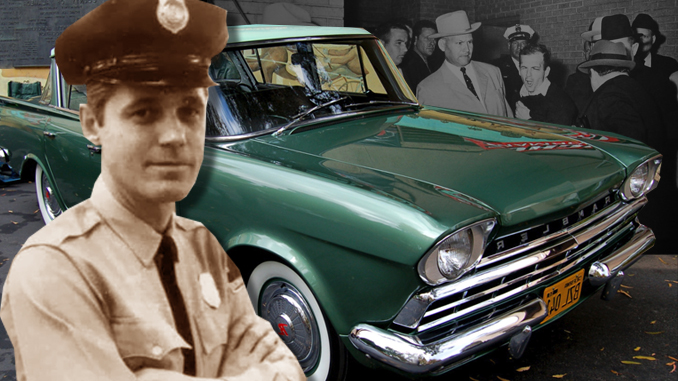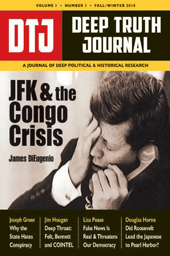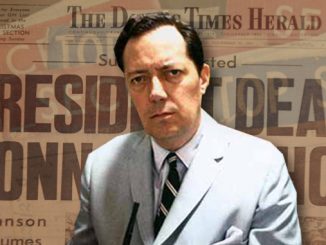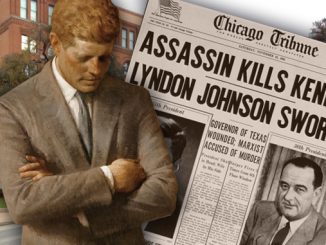
By Donald Jeffries
Roger Craig was about the only law enforcement officer at any level to do his job on Nov. 22, 1963, when President John F. Kennedy was assassinated in Dealey Plaza. Because he refused to toe the line like all of his peers, the former Dallas Deputy of the Year’s personal and professional life unraveled.
 Craig’s manuscript When They Kill a President is now available, thanks to filmmaker Steve Cameron, who is also the author of The Deputy Interviews and was the first researcher to work with Roger Craig Jr., son of the late deputy. This writer interviewed both Cameron and Craig Jr. some months ago on the weekly radio show “I Protest,” and was asked to write the preface to When They Kill a President.
Craig’s manuscript When They Kill a President is now available, thanks to filmmaker Steve Cameron, who is also the author of The Deputy Interviews and was the first researcher to work with Roger Craig Jr., son of the late deputy. This writer interviewed both Cameron and Craig Jr. some months ago on the weekly radio show “I Protest,” and was asked to write the preface to When They Kill a President.
“I began studying Roger Craig’s life, his death, and his relation to Kennedy’s assassination around the year 2012,” Cameron explained. “I quickly became fascinated with his story, and I wanted to learn as much about him as I could. So, I decided to reach out to people who knew him, including family members, to try to get to the truth, because there were so many unanswered questions and rumors and outright lies about him swirling around the internet regarding what he actually witnessed and what he went through after the assassination. What I discovered—and this is all documented in my recent book The Deputy Interviews—was that Craig was not only one of the most credible key witnesses to the JFK assassination case, but he was also someone who truly cared about his country—so much so that he was willing to lose everything he had while trying to right the enormous wrong that occurred to it on Nov. 22, 1963. He’s a hero in my book, and his memory should never be forgotten. I’m doing everything I can to ensure he is remembered.”
Craig saw a man he said resembled Lee Harvey Oswald hurriedly moving away from the Texas School Book Depository Building and entering a Rambler station wagon, moments after the assassination. Several other witnesses, all unconnected to each other, reported the same thing. Craig raced to the grassy knoll area after the shots were fired, as did almost everyone in the plaza. A majority of witnesses, in fact, testified that the shots had come from there. He conducted some of the first interviews with those on the grassy knoll. Craig was also present when officers Seymour Weitzman and Eugene Boone discovered a rifle on the sixth floor of the Book Depository, where Oswald worked as a low-paid stock clerk. Both Weitzman and Boone signed sworn affidavits identifying the weapon as a German Mauser. Oswald was dubiously connected to an old and unreliable Italian Mannlicher Carcano rifle, which was summarily declared to be the murder weapon. Craig corroborated the identification of a Mauser, which alone would have exonerated Oswald.
Craig claimed to have sat in on the questioning of Oswald. All of these interrogation sessions, unbelievably enough, were unrecorded. He heard the alleged assassin shout, “Everyone will know who I am now,” as he slammed his fist down on the desk. Oswald also reacted to a mention of the Rambler station wagon by proclaiming, “It belongs to Mrs. Paine—leave her out of it,” according to Craig. Marina Oswald, the suspect’s wife, lived with Paine in a curious arrangement. Both Ruth and her estranged husband Michael Paine had a myriad of interesting connections to the case, to put it mildly.

Craig began working with some of the private critics who were exposing the lies of the Warren Commission. He became a pariah to Dallas law enforcement and was fired in 1967. He traveled to New Orleans and was a witness for Jim Garrison in the Clay Shaw trial. He would subsequently be shot at while taking a walk. Fortunately, the bullet only grazed his head. In 1973, his car was run off a mountain road by another vehicle, seriously injuring him. In 1974, he was shot at again, and in 1975 he was badly wounded when his car engine exploded. Finally, on May 15, 1975, Craig was found dead, at just 39 years old, from what were reported to be self-inflicted gunshot wounds. The circumstances of the crime scene indicate that this was instead a final attempt to silence him, which proved successful.
Craig began writing When They Kill a President in 1971. His story is important, and especially moving, considering that he was at the scene of the tragedy and one of the few who ever asked the right questions, and he paid the ultimate price for doing so. Craig suffered both professionally and personally, and eventually lost his life, for telling the truth. He was a genuine profile in courage.
Donald Jeffries is a highly respected author and researcher whose work on the JFK, RFK and MLK assassinations and other high crimes of the Deep State has been read by millions of people across the world. Jeffries is also the author of three books currently being sold by the AFP Online Store.





This is misleading, we now con confirm the true assassin is George Hickey, a SS member riding in the chase car with a AR-15. The CIA and opposition politicians perpetrated this assassination.